A few years ago we purchased a very simple trail camera to take along on our visits to South Africa’s wild places, reason being that we were interested to know and see what wildlife roamed around after the humans went to bed. During our week at Cape Vidal in the iSimangaliso Wetland Park a dripping geyser overflow that created a small puddle in hardened mud and a pie-dish beneath an outside tap were the perfect locations to set up our little “camera trap” and spy on the wild neighbours that roam the camp by day and night. The camera worked overtime and took thousands of photos, and with great excitement we’d download these on a daily basis to see what came to visit while we were either away or asleep.

Vervet Monkey sneaking a drink beneath the geyser overflow
As was to be expected a wide variety of birds were drawn to the artificial “waterholes” around our cabin. What made us really excited was the very many shots the camera got of usually very shy and retiring forest birds we would otherwise have broken our necks trying to sneak even a single photograph of.

Bearded Scrub-Robin

Dark-backed Weavers and a Grey-headed Sparrow

Dark-capped Bulbul

Green Twinspot

Green Twinspot

Green Twinspot

Grey-headed Sparrow

Grey-tit Flycatcher and Olive Sunbird, with Samango Monkeys in the background
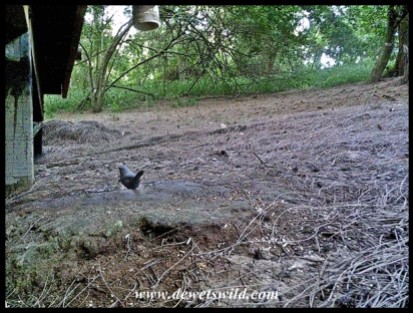
Grey Waxbill – the only appearance by this species on thousands of photos taken by the camera trap during our week at Cape Vidal

Livingstone’s Turacos

Livingstone’s Turacos

Livingstone’s Turacos

Livingstone’s Turacos

Livingstone’s Turacos

Livingstone’s Turaco

Olive Sunbird

Olive Sunbird

Pink-throated and Green Twinspots

Red-capped Robin Chat

Red-capped Robin Chat

Red-capped Robin Chat

Red-capped Robin Chat
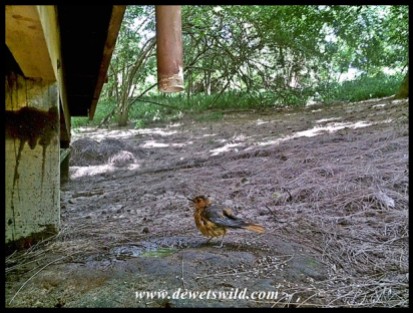
Red-capped Robin Chat

Red-capped Robin Chat

Red-capped Robin Chat

Red-capped Robin Chat

Red-capped Robin Chats

Tambourine Dove

Tambourine Dove

Tambourine Dove

White-eared Barbet

Yellow-bellied Greenbuls

Yellow-bellied Greenbuls

Yellow-fronted Canary, with a bushbuck in the background
By day the biggest mammals that roamed around the camp at Cape Vidal was the Bushbucks. Male and female, young and old, they all put in an appearance.

Very old Bushbuck ewe

Bushbuck ewe

Bushbuck ram

Bushbuck ram

Very old Bushbuck ewe

Bushbuck ram

Young Bushbuck

Young Bushbuck ram

Bushbuck ram and ewe

Bushbuck ewe
By far the species featured most often in the photos taken by the trailcam was the Samango Monkeys, and some of the things they got up to when they thought there weren’t any humans around to see was most amusing.

Samango Monkey

Samango Monkey

Samango Monkeys

Samango Monkeys

Samango Monkeys

Samango Monkey

Samango Monkey

Samango Monkeys

Samango Monkeys

Samango Monkey

Samango Monkey

Samango Monkey

Samango Monkeys

Samango Monkeys

Samango Monkey

Samango Monkeys

Samango Monkeys with a bushbuck in the background

Samango Monkey

Samango Monkeys

Samango Monkey with a bushbuck in the background

Samango Monkey with a bushbuck in the background

Samango Monkeys

Samango Monkey with a bushbuck in the background

Samango Monkeys with a bushbuck in the background

Samango Monkeys with a bushbuck in the background
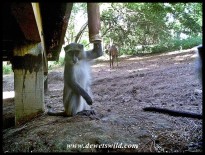
Samango Monkey with a bushbuck in the background

Samango Monkeys with abushbuck in the background

Samango Monkeys and a bushbuck in the background

Samango Monkeys

Samango Monkeys

Samango Monkey
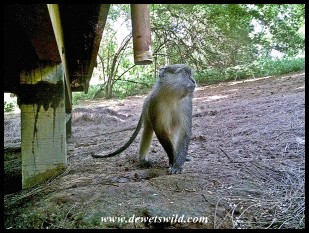
Samango Monkey

Samango Monkey mom and baby

Samango Monkey mom and baby

Samango Monkey mom and baby

Samango Monkey mom and baby

Samango Monkey mom and baby
Nighttime brought a shift in the animals coming to prowl around our accommodations – the bushbuck were still around and genets aren’t really threatening, but I wouldn’t want to encounter the bushpigs or hyenas in the dark!

Bushbuck ram outside our cabin in the dark of night

Bushbuck ram outside our cabin in the dark of night

Bushpig outside our cabin in the dark of night

Bushpigs outside our cabin in the dark of night
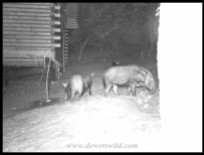
Bushpigs outside our cabin in the dark of night

Bushpigs outside our cabin in the dark of night

Bushpig outside our cabin in the dark of night

Bushpig outside our cabin in the dark of night

Bushpig outside our cabin in the dark of night

Bushpig outside our cabin in the dark of night

Bushpig outside our cabin in the dark of night

Bushpig outside our cabin in the dark of night

Bushpigs outside our cabin in the dark of night

Large-spotted Genet outside our cabin in the dark of night

Large-spotted Genet outside our cabin in the dark of night

Spotted Hyena outside our cabin in the dark of night

Spotted Hyena outside our cabin in the dark of night
-27.636136
32.582520
iSimangaliso Wetland Park, South Africa
Related





































































































So interesting to see all your visitors being so unselfconscious in front of the lens.
LikeLiked by 1 person
I was amazed at it too, Carol. I expected they’d be much more cautious about this strange new thing in their vicinity.
LikeLiked by 1 person
And it would seem that fresh water is a very valuable resource at Cape Vidal that so many creatures were eager to find.
LikeLiked by 1 person
There were rainwater puddles and pans everywhere in and outside camp, which made their attraction to our artificial waterholes even more strange!
LikeLiked by 1 person
Maybe this is another example of the unexpected relatively safety of hanging around camp grounds? After the prolonged drought in the region a few years back it is lovely to think about the area being so well off with water this season.
LikeLiked by 1 person
We’d seen most of northern KZN’s reserves at the height of the last drought, and that was awful. Seeing these places we love so dearly so green and lush is wonderful.
LikeLiked by 1 person
Great idea to bring that trail camera! The gallery of monkey images is fun to look at. You really get to see the birds and animals up close and personal when they think no one is looking.
LikeLiked by 1 person
It does bring a very interesting perspective on their habits, John, even if it is just a glimpse.
LikeLike
That’s an amazing collection of photos of hard to see, never mind photograph, bird and other species! That would get me up early just to see what’s been captured overnight. What is the camera that you use?
LikeLiked by 1 person
Thank you very much, Don! It’s a little GamePro 5 megapixel camera I picked up on a special from Takealot.
LikeLike
The draw of water. The Turacos are fantastic looking birds but trust them Robin-chats to mess it up for others!
Reminds me of a holiday to a Greek island where a leaking pipe (part of an underground fire prevention system) in a pine wood drew birds like a magnet, spent hours watching them.
LikeLiked by 1 person
It’s wonderful how quickly wildlife exploits opportunities like that to their advantage!
LikeLiked by 1 person
This is a fun adventure of its own – parallel to your own walks and drives through the area. I have often wondered about the sounds I hear in our garden at night …
LikeLiked by 1 person
Great fun to wonder what’s making noise outside in the dark when I’m out in one of our national parks or reserves, but terrifying when the same happens in Pretoria… 🙂
LikeLike
I know what you mean … I was thinking more along the lines of a brown mongoose or an owl. I like to keep the positive thoughts uppermost in the dark hours 🙂
LikeLiked by 1 person
😀
LikeLike
You sure chose an excellent location in which to set up your “spy” cam! Really interesting!
LikeLiked by 1 person
This is the kind of technology I love – bringing me even closer to nature!
LikeLiked by 1 person
Everybody goes to the downspouts to get some water. Is there a drought there right now?
I see many birds in that area. Are there many kinds of monkeys in the park? Thank you, D. 🙂
LikeLiked by 1 person
Thanks for the interesting questions, H.J!
Being forest animals the creatures that roam Cape Vidal are water-dependent and so drink water any chance they get. The Park has had excellent rainfall this year and is lush and green with natural water easily available all over.
iSimangaliso has a list of 526 bird species that occur there and, excluding humans, 4 of the 5 primate species that occur naturally in South Africa can be seen there: Chacma Baboon, Samango Monkey, Vervet Monkey and Thick-tailed Bushbaby.
LikeLiked by 1 person
Thank you, D. 🙂
LikeLiked by 1 person
I so enjoyed seeing all these photos of your visitors.
LikeLiked by 1 person
We were also very excited everyday when we checked the camera to see what came to visit, Anne!
LikeLike